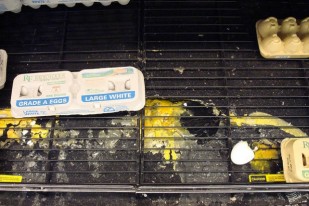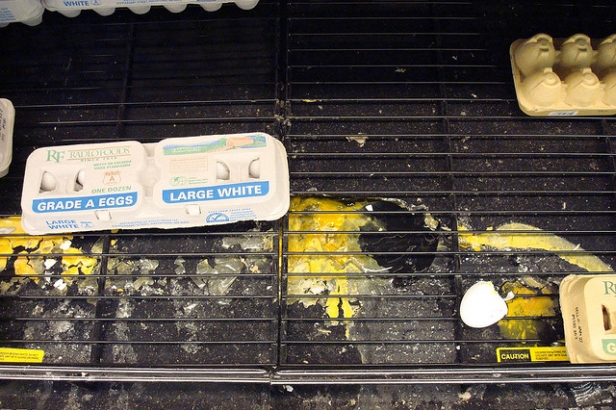 How low can they go? (Photo taken in a Massachusetts Walmart)Photo: Svadilfari via FlickrEgg prices are on the upswing in the wake of the massive salmonella recall. Wright County Egg and Hillandale Farms, two of the ten largest egg U.S. producers, have been pushed out of the fresh-egg market pending investigation. With fewer eggs available, the wholesale price of a dozen eggs has risen dramatically since the recall, as much as 40 percent in some regions.
How low can they go? (Photo taken in a Massachusetts Walmart)Photo: Svadilfari via FlickrEgg prices are on the upswing in the wake of the massive salmonella recall. Wright County Egg and Hillandale Farms, two of the ten largest egg U.S. producers, have been pushed out of the fresh-egg market pending investigation. With fewer eggs available, the wholesale price of a dozen eggs has risen dramatically since the recall, as much as 40 percent in some regions.
But even with the recent hikes, eggs are really, really cheap. Just last week, the Walmart in Boone, N.C., was selling an 18-pack of eggs for $1.86 — about a dime an egg. In normal times, a Boone-based Walmart employee told me over the phone, the retail behemoth sells a dozen eggs for as low as $0.89, or less than 8 cents an egg. I imagine when the salmonella-choked dust clears on the recall, prices will quickly revert to the mean.
What Walmart hails as “everyday low prices” form the foundation of our food system — the cheapest one on the planet in terms of food expenditures per capita as a percentage of income. The company itself has perfected a business model predicated on making money by selling high volumes of dirt-cheap food.
In the past couple of years, a growing literature has documented how Walmart’s meteoric rise to near dominance of the U.S. grocery market has helped transform the food system into a cheap-food machine dominated by a few companies. Barry C. Lynn’s 2010 book Cornered: The New Monopoly Capitalism and the Economics of Destruction is probably the best account. (His discussion of Walmart’s role in the food system was first published as a luminous 2006 Harper’s piece.) As recently as 1998, Walmart was a bit player in the U.S, grocery market, responsible for less than 6 percent of total grocery sales. Today, its market share stands at 23 percent — higher than the combined share of its three biggest rivals, Kroger, Safeway, and Supervalue. Lynn documents how Walmart uses its might to squeeze its suppliers, forcing them to slash costs and scale up to remain profitable.
The current egg recall, which grew out of filthy conditions on factory-scale Iowa egg facilities (detailed in my last post), can only be fully understood within this context. Profit margins on eggs that retail for 8 cents apiece are nano-thin; in order to make money, producers have no choice but to think in terms of massive volume. And they have to be ruthless about controlling costs.
In a market predicated on cost cutting, the winners aren’t the players that produce the highest-quality eggs or maintain the best production standards. Instead, the spoils go to the ones that produce the most eggs at the cheapest price. And that means severe pressure to cut corners on food safety, building maintenance, working conditions, etc. As the career of Wright County Egg Owner Jack DeCoster shows, fines from violations of worker-safety, sanitation, and water-quality laws become a mere cost of doing business.
If a piston in a car factory wears out on the production line, your car won’t catch a contagious disease. But when laying hens are routinely left to die slowly in cages in close quarters with other birds, all in proximity to vast piles of manure, all products that emerge must be treated as biohazardous material.
Indeed, the conditions the FDA discovered in Wright County Egg’s huge laying house are disgusting, but not particularly remarkable. Just this past spring, Humane Society of the United States (HSUS) representatives infiltrated operations run by two of Wright County Egg’s largest rivals, Rose Acre Farms and Rembrandt Enterprises. What they found were birds stuffed into cages and treated not as productive living creatures, but rather as cheap, disposable inputs in an industrial process.
It’s worth quoting HSUS’s findings at Rose Acre Farms at length:
Prolapsed uteruses: Hens in intensive laying facilities often suffer from “blow-outs” (when the uterus collapses and protrudes from the body) that go unnoticed and untreated due to the cage crowding.
Trapped birds unable to reach food and water: Battery cages can trap hens by their wings, necks, legs, and feet in the wire, causing other birds to trample the weakened animals, usually resulting in a slow, painful death.
High mortality in layer and pullet sheds: The HSUS investigator working in the Winterset pullet sheds pulled dead young hens, some of them mummified (meaning they’d been rotting in the cages for weeks), from cages every day.
Failure to maintain manure pits: According to one worker, the manure pit under a pullet shed had not been cleaned in two years. The ammonia levels caused the investigator respiratory distress despite the painter’s face mask he wore. Rose Acre workers claimed that some hens are blinded because of excessive ammonia levels.
Abandoned hens: Some hens manage to escape from their cages and fall into the manure pits below.
Now, one obvious problem of treating birds like cogs in an egg machine instead of living beings is that mechanical objects don’t breed microbial and viral pathogens. If a piston in a car factory wears out on the production line, your car won’t catch a contagious disease. But when laying hens are routinely left to die slowly in cages in close quarters with other birds, all in proximity to vast piles of manure, all products that emerge must be treated as biohazardous material.
And indeed, the HSUS delivers overwhelming evidence that salmonella infection rates are significantly higher in caged systems than in non-cage systems. Even in normal years without a spectacular recall like the current one, some 140,000 Americans fall ill with salmonella from infected eggs. This system, predicated on high volume and low operating costs, is what’s responsible for pathogen-friendly conditions within egg factories — not just a few rotten eggs like DeCoster.
As the current salmonella scare plays out, you can bet techno-fixes to the problem will be proposed: stuff like vaccinations and increased use of anti-microbials. But in the end, the effectiveness of those measures will be outweighed by the economic imperative to stuff as many birds together as possible to keep production costs at rock bottom, and the biological reality that pathogens tend to mutate faster than technological responses to them can keep pace.
The real solution to chronic food-system problems like salmonella-riddled eggs is to reform the economic structures that cause them. The U.S. Justice Department and the USDA have been holding public hearings on con
solidation in the food system — the effects on farmers when fewer and fewer companies process ever-greater shares of the food that ends up on people’s plates. Those talks should be broadened to include consolidation’s effect on food safety.
And, as the United Food and Commercial Workers Union argues in an incisive recent report, Walmart should also be on the discussion table for its role in driving food-system consolidation.



